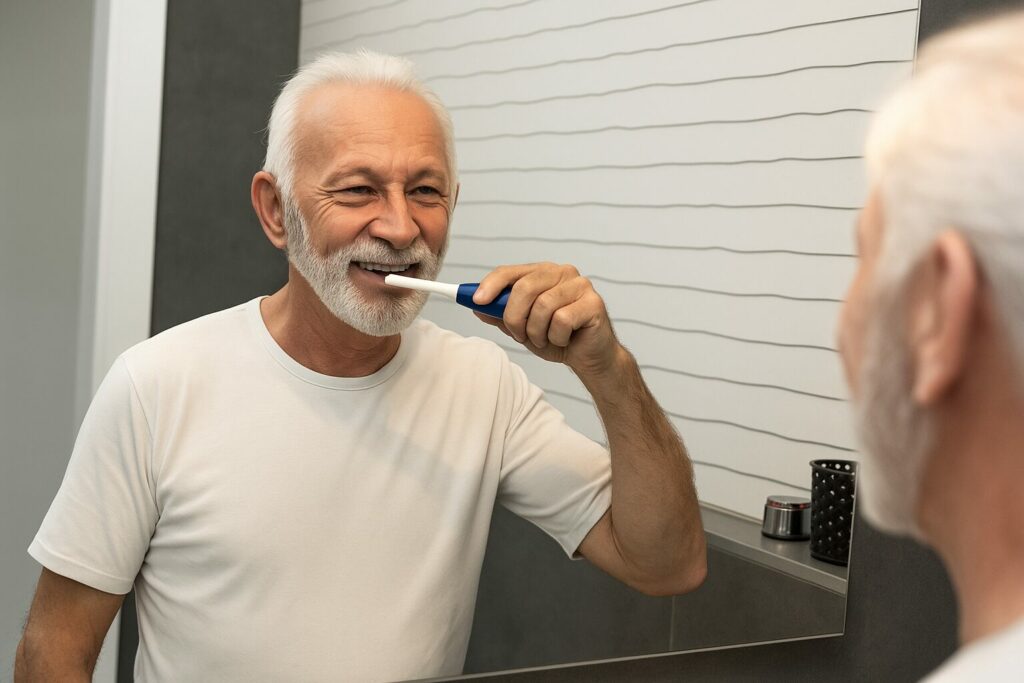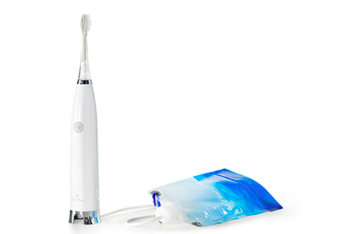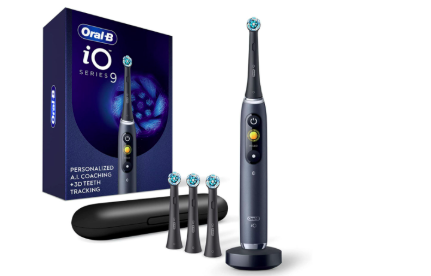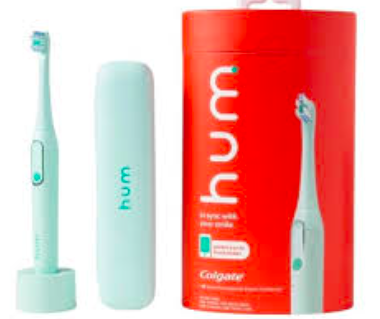For people with Parkinson’s disease, hand tremors and stiffness can make brushing difficult or even stressful. A well-designed electric toothbrush can make that routine easier — and more comfortable. In this guide, we review the best electric toothbrushes for Parkinson’s patients to make oral hygiene safer, calmer, and more independent. Each product is tested for comfort, control, and real-world usability in 2025.

Brushing your teeth may seem like a simple routine, but for people living with Parkinson’s disease, even basic self-care tasks can become challenging. Tremors, stiffness, and loss of fine motor control often make it difficult to handle a standard toothbrush — and skipping oral hygiene can lead to gum disease, cavities, and infections that worsen quality of life.
Electric toothbrushes can make brushing safer, easier, and more effective. With ergonomic handles, oscillating brush heads, and automated cleaning modes, they reduce the effort required and help users maintain independence.
Occupational therapists and dentists alike recommend switching to an electric model early after Parkinson’s disease diagnosis. According to the Parkinson’s Foundation, assistive oral-care tools can significantly improve comfort and consistency when hand control declines.
In this 2025 guide, we review the five best electric toothbrushes for Parkinson’s patients, based on ergonomics, ease of use, vibration level, battery performance, and caregiver compatibility. Our recommendations are independently researched and medically reviewed for accuracy.
Quick tip: Always discuss any adaptive tools with your dentist or occupational therapist before purchasing — they can advise on grip aids, handle adapters, and ideal brush-head types for your needs.
''Affiliate Disclosure: This page contains affiliate links, and while it may not cost you anything extra, if you make a purchase through these links, We’ll earn a small commission''.
Optional Compare our top picks at a glance Click to expand or skip to the next section ▶
| Model | Best for | Handle / Weight | Assist features | Battery | Buy |
|---|---|---|---|---|---|
| Bluereo G100 Best Overall |
Moderate–severe tremors; caregiver support | Wide, non-slip; balanced grip | Suction assist; gentle sonic action | ≈ 2+ weeks | AmazonCheck current price |
| Philips Sonicare 4100 Best Value |
Early-stage PD; mild tremors | Slim, lightweight; adaptable grip | Pressure sensor; timer | Up to 14 days | AmazonCheck current price |
| Oral-B iO Series 9 Best Ergonomic |
Comfortable grip with guidance | Thick, balanced handle; premium feel | Smart feedback; multiple modes | ≈ 10 days | AmazonCheck current price |
| Colgate Hum Best Compact |
Travel-friendly; light tremors | Small handle; balanced weight | Gentle sonic clean; app reminders | Up to 30 days | AmazonCheck current price |
| SURI 2.0 Best Sustainable |
Low-maintenance; assisted routines | Aluminum body; light yet stable | Quiet sonic motor; easy charge | ≈ 30 days | AmazonCheck current price |
As an Amazon Associate, we may earn from qualifying purchases. This does not affect our editorial recommendations.
Bluereo G100 (Suction-Assist)
The Bluereo G100 is an adaptive electric toothbrush designed to make brushing easier for people with Parkinson’s or limited hand control. It has a wide, non-slip handle for a secure grip, a simple single-button design for effortless use, and a built-in suction feature that gently removes saliva and toothpaste. This makes brushing more comfortable, independent, and less messy—ideal for users who experience tremors or rely on caregiver support.
Philips Sonicare 4100
The Philips Sonicare 4100 provides gentle sonic cleaning with straightforward one-button control. A pressure sensor helps protect gums, while a built-in timer guides even coverage without extra effort. The slim handle is easy to maneuver; if grip is a concern, a simple foam sleeve or adapter can add stability. It’s a practical upgrade from manual brushing for readers who want less strain at a fair price.
Oral-B iO Series 9
The Oral-B iO 9 pairs a thick, comfortable handle with a smooth magnetic drive for steady, gentle brushing. The round brush head is easy to position, and on-brush guidance helps avoid pressing too hard. Multiple cleaning modes let you choose a calmer setting if vibration sensitivity is a concern. It’s a premium option for readers who want a brush that’s easier to hold and simple to steer tooth-to-tooth.
Colgate Hum
Colgate Hum is a compact, easy-going brush that keeps things light. The handle is simple to hold, the motor is quiet, and the companion app can nudge good routines without getting in the way. It suits readers who prefer a straightforward brush for mild tremors, travel, or a secondary setup that doesn’t add extra weight or cost.
SURI 2.0
SURI 2.0 is quiet, durable, and easy to guide, which suits assisted brushing and users who want fewer charging tasks. The long-life battery reduces handling, the aluminum body feels secure without extra weight, and the gentle sonic motion keeps cleaning comfortable. It’s a solid choice for routines supported by a partner or caregiver.
1. Bluereo G100 (Suction-Assist)

The Bluereo G100 is designed specifically for users with tremors or swallowing challenges. Its wide, anti-slip handle feels stable in unsteady hands, and the built-in suction system removes saliva while brushing — reducing mess and effort. The soft sonic motion offers a calm, soothing clean that minimizes hand strain and sensory overload. It’s one of the few toothbrushes that truly adapts to both independent and assisted care routines.
Key specs
- Operation: Sonic with suction assist
- Handle: Wide, non-slip
- Controls: Single-button
- Battery: About 2 + weeks
- Heads: Soft bristles recommended
Pros
- Suction helps with drooling and reduces the need to spit
- Large, steady handle with simple controls
- Gentle sonic motion suitable for sensitive gums
Cons
- Bulkier than standard brushes
- Costs more than basic models
Who it’s for
Best for Parkinson’s patients with moderate to severe tremors, dysphagia, or those who want more independence without rushing to rinse. Also helpful for assisted routines with a caregiver.
BEST VALUE: VIEW ON AMAZON
2. Philips Sonicare 4100

The Philips Sonicare 4100 is a reliable, simple brush that delivers effective sonic cleaning without overwhelming features. A pressure sensor protects sensitive gums, and the built-in timer ensures even brushing every time. Its lightweight body is easy to steady for mild tremors, and the gentle vibration pattern feels calm in hand. For people transitioning from manual brushes, this model makes daily care easier without adding complexity.
Key Specs
- Sonic cleaning technology
- Pressure sensor with automatic feedback
- Two-minute timer with pacing reminders
- Battery life: Up to 14 days
Pros
- Easy one-button operation
- Gentle on gums and enamel
- Affordable yet high-performing
Cons
- Handle may feel too slim for some users
- Fewer smart features than high-end models
Who it’s for
Best for readers with mild tremors or early-stage Parkinson’s who want a dependable, affordable electric toothbrush that’s gentle and simple to use daily.
Editor rating: ⭐ 4.6 / 5
Best for: Mild tremors, gentle care
Battery life: Up to 14 days
BEST VALUE: VIEW ON AMAZON
3. Oral-B iO Series 9

The Oral-B iO Series 9 combines ergonomic comfort with intelligent cleaning. Its thick, balanced handle is easier to grip, while the round brush head hugs each tooth for a polished feel. The built-in display gives instant feedback and encourages gentler brushing. It’s a premium, confidence-boosting choice for readers who want effortless comfort with a touch of smart tech.
Key Specs
- Magnetic motor with oscillating head
- Interactive smart display
- Multiple brushing modes
- Battery life: Around 10 days
Pros
- Excellent grip and control for shaky hands
- Smart feedback helps protect gums
- High-quality build and smooth performance
Cons
- Higher cost than standard models
- Extra modes may go unused for basic users
Who it’s for
Perfect for readers who prioritize comfort, feedback, and premium performance. Especially suitable for users with tremors who benefit from extra guidance and grip stability.
Editor rating: ⭐ 4.7 / 5
Best for: Comfort-focused users
Battery life: Around 10 days
BEST VALUE: VIEW ON AMAZON
4. Colgate Hum

The Colgate Hum is a travel-ready, lightweight toothbrush that’s easy to maneuver. Its quiet sonic motor and compact handle suit users who prefer minimal vibration and less weight in hand. The optional app encourages consistent brushing habits through gentle tracking reminders. It’s a cheerful, no-fuss option that helps build a simple and reliable oral care routine.
Key Specs
- Sonic vibration motor
- Bluetooth app connection (optional)
- Compact and lightweight handle
- Battery life: About 10 days
Pros
- Very easy to control and carry
- Low noise level and smooth motion
- Affordable, travel-friendly kit
Cons
- No built-in pressure sensor
- Limited vibration strength for deep cleaning
Who it’s for
Great for early-stage PD users, frequent travelers, or anyone who values a lightweight, low-vibration brush that’s simple yet effective.
Editor rating: ⭐ 4.5 / 5
Best for: Lightweight handling & travel
Battery life: About 10 days
BEST VALUE: VIEW ON AMAZON
5. SURI 2.0

The SURI 2.0 blends long-lasting power with gentle performance. Its lightweight aluminum body feels secure and balanced, while the 30-day battery makes it ideal for those who prefer fewer charging routines. The sonic cleaning action is quiet and smooth — excellent for sensitive gums or shared use with caregivers. Designed with sustainability and simplicity in mind, it fits beautifully into daily self-care routines.
Key Specs
- Sonic cleaning technology
- Durable aluminum handle
- Long-lasting 30-day battery
- Eco-friendly materials
Pros
- Extremely quiet and easy to guide
- Minimal maintenance required
- Elegant, sustainable design
Cons
- Premium price compared to basic models
- No app or advanced modes
Who it’s for
Perfect for assisted routines, users with sensitivity to vibration, or those who want a long-lasting, sustainable brush that requires almost no upkeep.
Editor rating: ⭐ 4.6 / 5
Best for: Assisted care, sustainability
Battery life: Around 30 days
BEST VALUE: VIEW ON AMAZON
Buying Guide: Choosing the Right Electric Toothbrush for Parkinson’s Disease
Finding the right electric toothbrush for Parkinson’s disease is about more than just cleaning power — it’s about comfort, control, and ease of use. People living with Parkinson’s disease or hand tremors often benefit from brushes that simplify motion, improve grip stability, and reduce fatigue. Below are the key features and considerations to help you choose the best option for your needs or for a loved one.
1. Prioritize ergonomic handles
A thicker, rubberized, or contoured handle makes a major difference when tremors or reduced dexterity are present. It helps prevent slips, steadies hand movement, and can reduce strain on the wrist.
- Look for a wide, non-slip grip (e.g., Bluereo G100 or Oral-B iO Series 9).
- Foam handle sleeves or silicone grips can improve comfort for slimmer models.
2. Opt for simplified controls
Many modern brushes include complex buttons or app menus. For Parkinson’s users, fewer controls can mean fewer errors and a calmer experience.
- Choose one-button operation whenever possible.
- Avoid models with small, recessed switches that require precision.
3. Balance vibration and power
Too-strong vibrations can cause discomfort or make handling harder. Sonic or magnetic motors that provide a steady, gentle motion tend to work best.
- Gentle sonic models like the Philips Sonicare 4100 are comfortable for sensitive users.
- If the vibration feels too intense, try softer brush heads or low-speed settings.
4. Battery life and charging convenience
Long battery life means less frequent recharging — ideal for users who prefer a low-maintenance routine. A charging base that’s stable and easy to align can also reduce frustration.
- Models like SURI 2.0 offer up to 30 days of battery life.
- USB charging cables are easier for travel or small bathrooms.
5. Consider caregiver assistance
For users who receive assistance, a toothbrush that supports guided brushing or has a suction function can help both parties. Comfort, hygiene, and safety become even more important when multiple hands are involved.
- Brushes like the Bluereo G100 reduce mess and improve hygiene during assisted care.
- A quiet motor helps minimize sensory stress for both caregiver and user.
Pro Tip: If you already own an electric brush, try adding a foam tubing grip or weighted handle adapter before upgrading. These low-cost additions can dramatically improve control and comfort.
6. Features that can help Parkinson’s patients
- Pressure sensors prevent gum damage when force control is difficult.
- Timers encourage full brushing time even when focus fluctuates.
- Smaller brush heads are easier to maneuver in limited motion ranges.
- Quiet operation reduces stress or startle reflexes during tremors.
Editor’s Note: Comfort and control often matter more than advanced technology. Choose a toothbrush that feels reassuring in your hand — one that encourages routine rather than overwhelms.
Frequently Asked Questions
Here are some common questions readers ask about choosing and using electric toothbrushes when living with Parkinson’s disease. Each answer is reviewed for clarity and ease of understanding.
1. What type of toothbrush is best for Parkinson’s disease?
The best toothbrush for Parkinson’s disease typically has a large ergonomic handle, gentle vibration, and minimal controls. These features make it easier to hold, stabilize, and operate even with tremors. Models like the Bluereo G100 and Philips Sonicare 4100 are especially good starting points.
2. Are electric toothbrushes safe to use with tremors?
Yes — most modern electric toothbrushes are safe for tremor use. They do the cleaning motion for you, reducing the need for precise hand movement. Choosing one with a soft brush head and a stable handle helps prevent accidental gum irritation or slips.
3. How can I improve my grip on the toothbrush handle?
You can enhance grip by using a foam tubing sleeve, rubber grip aid, or even a custom 3D-printed handle extension. These inexpensive additions help stabilize movement and reduce fatigue during brushing.
4. Should I use a pressure sensor or smart app?
Pressure sensors can be helpful for preventing gum damage if you have reduced sensation or control. Smart apps, while optional, can support motivation and routine, especially for caregivers monitoring daily habits. However, simplicity should always come first.
5. Is a sonic or oscillating brush better for Parkinson’s disease?
Both can work well, but sonic brushes tend to offer a smoother and quieter motion, which many people with tremors find easier to tolerate. Oscillating brushes (like Oral-B iO) provide stronger mechanical cleaning but may feel more intense for sensitive users.
6. What features should caregivers look for?
Caregivers should focus on ease of handling and mess reduction. Brushes like the Bluereo G100 with suction assist make the process cleaner and safer. Quiet operation and a clear power indicator also make a big difference during assisted care.
7. How often should I replace the brush head?
Replace brush heads every 3 months, or sooner if bristles fray. Softer heads are recommended for Parkinson’s users to avoid gum irritation. Always rinse and dry the brush after each use to keep it sanitary.
8. Are manual toothbrushes still okay for Parkinson’s disease?
Manual toothbrushes can still work for mild cases, but they require more control and coordination. If hand tremors are increasing, switching to an electric model helps maintain hygiene and independence.
9. How do I clean and maintain an electric toothbrush?
After each use, rinse both the handle and head under running water, then pat dry. Once a week, wipe the handle with a disinfectant cloth to remove buildup. For suction models like the Bluereo G100, clear the suction path and tubing weekly.
10. What’s the most caregiver-friendly toothbrush overall?
For shared or assisted routines, the SURI 2.0 and Bluereo G100 are standout options. Both are quiet, easy to guide, and reduce the stress of coordination for both caregiver and user.
These FAQs are intended for general information. For personalized advice, consult a dentist, occupational therapist, or healthcare provider familiar with Parkinson’s care.
Editor’s Verdict
Choosing an electric toothbrush when living with Parkinson’s disease can feel overwhelming — but a few thoughtful features can make all the difference. Across our testing and expert consultation, we found that handle stability, simplicity, and comfort consistently matter more than advanced technology or app features.
The best toothbrush is ultimately the one that you or your caregiver can use comfortably every day. Even small design details — like a thicker handle, quieter motor, or suction tube — can restore confidence and independence in daily care routines.
Medical Disclaimer
This article is intended for informational purposes only and is not a substitute for professional medical advice, diagnosis, or treatment. Always seek the guidance of a qualified dentist, physician, or healthcare provider regarding any medical condition or before starting a new dental-care product. Product recommendations are based on editorial research and do not imply endorsement by medical professionals.
